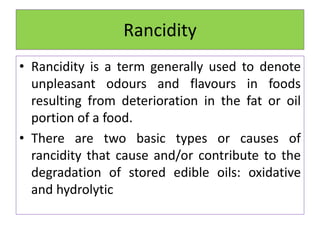
Rancidity and hydrolysis18.07.2020
- 1. Rancidity • Rancidity is a term generally used to denote unpleasant odours and flavours in foods resulting from deterioration in the fat or oil portion of a food. • There are two basic types or causes of rancidity that cause and/or contribute to the degradation of stored edible oils: oxidative and hydrolytic
- 3. Types •Oxidative Rancidity •Hydrolytic Rancidity a.Enzymatic Rancidity b.Microbial rancidity
- 4. Oxidative rancidity Autoxidation, occurs when oxygen is absorbed from the environment
- 5. Oxidation of fat • Oil oxidation is an undesirable series of chemical reactions involving oxygen that degrades the quality of an oil. • Oxidation eventually produces rancidity in oil, with accompanying off flavours, foul-tasting and horrible smells. • All oil is in a state of oxidation - you cannot stop it completely - but there are ways to reduce it.
- 6. Oxidation of fat • Oxidation of fatty acid alkenes involves cleavage of the double bonds to form short- chain carboxylic acids. • When oil oxidises it produces a series of breakdown products in stages, starting with primary oxidation products (peroxides, dienes, free fatty acids), then secondary products (carbonyls, aldehydes, trienes) and finally tertiary products.
- 8. Auto-oxidation The process of oxidation induced by air at room temperature referred to as “autoxidation”. Oxidation progresses at different rates depending on factors such as • Temperature, • Light, • Availability of oxygen, • Presence of moisture and metals (such as iron) .
- 9. Auto-oxidation Ordinarily, this is a slow process which occurs only to a limited degree. However, factors such as the presence of light can increase the rate of oxidation. Metals, such as copper or iron, present at low levels in fats and oils can also promote autoxidation.
- 10. Prevent oxidation Several different factors can be controlled to reduce the amount of oxidation that occurs in your oil. • Temperature - the number one contributing factor of oxidation in oil. If possible reduce the temperature to the lowest possible throughout processing, shipping and manufacture. • Oxygen exposure (in the air) will be a catalyst for production of free radicals. To reduce oxidation, seal all containers with the smallest possible headspace, reduce the area of the oil in contact with air and/or cover the oil with an inert gas (like nitrogen) at all possible points.
- 11. Prevent oxidation • Light (UV) can trigger the oxidative degenerative cascade. Reduce the exposure of the oil to direct light by using brown glass/plastic containers or black plastic bags. • Moisture in combination with these other factors can accelerate oxidation. If possible limit the amount of water in the oil to less than 0.2%.
- 12. Prevent oxidation • Transition metals, in particular transition metals like iron and copper, can act as pro-oxidants. • Fats and oils are normally treated with chelating agents such as citric acid to complex these trace metals (thus inactivating their prooxidant effect). • If possible, you may need to change equipment (e.g. no brass valves), • limit time in contact with and/or • remove transition metals from the oil to reduce oxidation.
- 13. Antioxidants
- 14. Antioxidants (AOX) • Antioxidants (AOX) terminate the oxidation chain reactions and inhibit other oxidation reactions by being oxidised themselves. AOX do not stop oxidation, but do slow down the rate at which oxidation occurs. • There are many different ways AOX can reduce oxidation, so it is important to choose the right AOX for your application/product. • AOX can be synthetic or extracted from natural plant sources.
- 15. Common AOX are: • Tocopherols (vitamin E) • Carotenoids β-carotene • Phospholipids • Retinol (vitamin A)
- 16. Synthetic Antioxidant • BHT- butylated hydroxytoluene • BHA - butylated hydroxyanisole • TBHQ - tert-Butylhydroquinone • Propyl gallate • Ethoxyquin
- 17. Natural Antioxidant • Flavonoids • Rosemary • Spice extracts • Tea • Catechins • Seaweed
- 18. Preventive AOX • Citric acid, • Phosphoric acid, • Ascorbic acid (vitamin C), • Ethylene diamine tetraacetic acid (EDTA), • Uric acid
- 19. Hydrolysis
- 20. Hydrolysis Hydrolytic rancidity, also called hydrolysis or enzymatic oxidation, occurs in the absence of air, but with moisture present.
- 21. Enzyme hydrolysis Enzymes found naturally in plant oils (i.e., lipoxygenase, cyclooxygenase) and animal fats (i.e., lipase) can catalyze reactions between water and oil
- 23. Microbial rancidity Microbial rancidity, in which micro- organisms such as bacteria, molds and yeast use their enzymes to break down chemical structures in the oil, producing unwanted odors and flavors. Water needs to be present for microbial growth to occur.